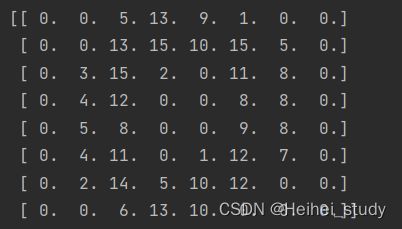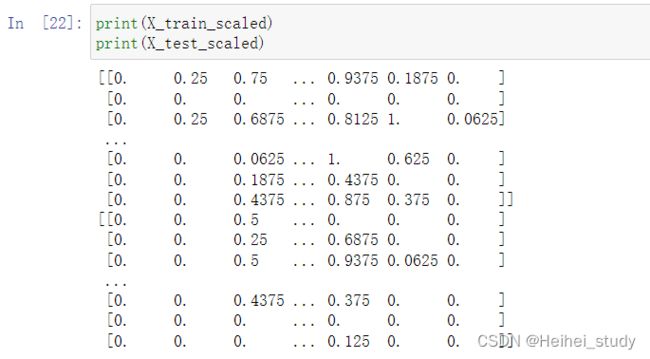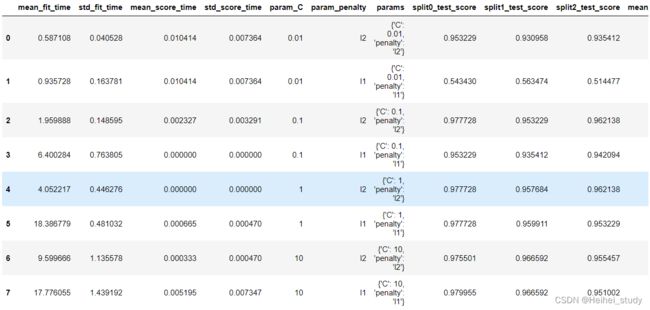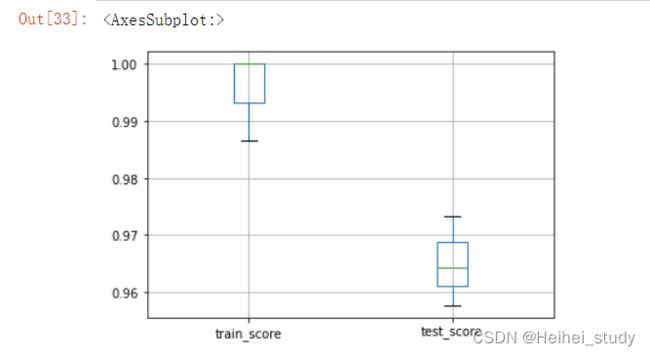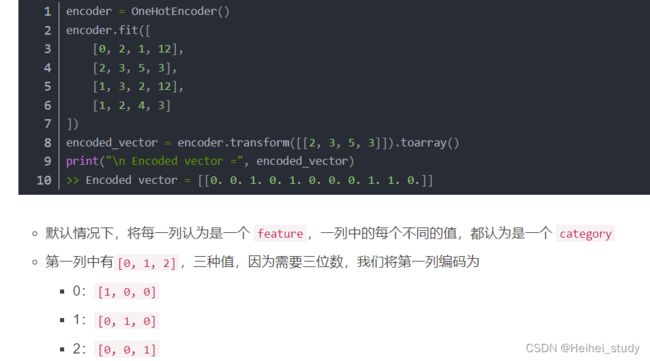任务四 机器学习库Scikit-learn
目录
一、训练和测试分类器
手写数字集
划分数据集和训练集
模型和预测
LogisticRegression分类器
RandomForestClassifier
XGBClassifier
GradientBoostingClassifier
balanced_accuracy_score
SVC
LinearSVC
二、标准化数据
归一化
数据标准化
训练和测试这个模型并得到归一化后的数据集
三、交叉验证
四、网络搜索调参
五、流水线操作
六、练习 异构数据:当您使用数字以外的数据时
导入数据
将数据集转换为x,y
处理分类数据 (将其转换为数字特征)
将处理好的分类特征和数值特征转换为稀疏矩阵
建模预测
一、训练和测试分类器
我们使用digits数据集,这是一个手写数字的数据集。
手写数字集
from sklearn.datasets import load_digits
X, y = load_digits(return_X_y=True)查看X[0]的数据
print(X[0].reshape(8,8))
打印出X[0]的图像
plt.imshow(X[0].reshape(8, 8), cmap='gray');# 下面完成灰度图的绘制
# 灰度显示图像
plt.axis('off')# 关闭坐标轴
print('The digit in the image is {}'.format(y[0]))# 格式化打印
#The digit in the image is 0
可以推测X是8*8(64个像素点)图的每个像素点的值,y则是X所对应的数字
划分数据集和训练集
train_test_split(X, y, stratify=y)_搬砖工友的博客-CSDN博客_stratify=y
Cross_validation.train_test_split 中 stratify这个参数的意义是什么?_weixin_30514745的博客-CSDN博客
from sklearn.model_selection import train_test_split
X_train, X_test, y_train, y_test = train_test_split(
X, y, stratify=y, test_size=0.25, random_state=42)
# 划分数据为训练集与测试集,添加stratify参数,以使得训练和测试数据集的类分布与整个数据集的类分布相同。模型和预测
一旦我们拥有独立的培训和测试集,我们就可以使用fit方法学习机器学习模型。 我们将使用score方法来测试此方法,依赖于默认的准确度指标。
Python机器学习sklearn里的score()方法,主要用于度量给定测试集的预测效果的好坏。
LogisticRegression分类器
from sklearn.linear_model import LogisticRegression # 求出Logistic回归的精确度得分
clf = LogisticRegression(
solver='lbfgs', multi_class='ovr', max_iter=5000, random_state=42)
clf.fit(X_train, y_train)
accuracy = clf.score(X_test, y_test)
print('Accuracy score of the {} is {:.4f}'.format(clf.__class__.__name__,
accuracy))LogisticRegression - 参数说明_Jark_的博客-CSDN博客_logisticregression函数
回归模型的精确度大致为0.9622
RandomForestClassifier
scikit-learn的API在分类器中是一致的。因此,我们可以通过RandomForestClassifier轻松替换LogisticRegression分类器。这些更改很小,仅与分类器实例的创建有关。
from sklearn.ensemble import RandomForestClassifier
# RandomForestClassifier轻松替换LogisticRegression分类器
clf = RandomForestClassifier(n_estimators=1000, n_jobs=-1, random_state=42)
clf.fit(X_train, y_train)
accuracy = clf.score(X_test, y_test)
print('Accuracy score of the {} is {:.2f}'.format(clf.__class__.__name__, accuracy))XGBClassifier
from xgboost import XGBClassifier
clf = XGBClassifier(n_estimators=1000)
clf.fit(X_train, y_train)
accuracy = clf.score(X_test, y_test)
print('Accuracy score of the {} is {:.2f}'.format(clf.__class__.__name__, accuracy))GradientBoostingClassifier
from sklearn.ensemble import GradientBoostingClassifier
clf = GradientBoostingClassifier(n_estimators=100, random_state=0)
clf.fit(X_train, y_train)
accuracy = clf.score(X_test, y_test)
print('Accuracy score of the {} is {:.2f}'.format(clf.__class__.__name__,
accuracy))Accuracy score of the GradientBoostingClassifier is 0.96
balanced_accuracy_score
from sklearn.metrics import balanced_accuracy_score
y_pred = clf.predict(X_test)
accuracy = balanced_accuracy_score(y_pred, y_test)
print('Accuracy score of the {} is {:.2f}'.format(clf.__class__.__name__,
accuracy))![]()
SVC
from sklearn.svm import SVC, LinearSVC
clf = SVC()
clf.fit(X_train, y_train)
accuracy = clf.score(X_test, y_test)
print('Accuracy score of the {} is {:.2f}'.format(clf.__class__.__name__,
accuracy))LinearSVC
clf = LinearSVC()
clf.fit(X_train, y_train)
accuracy = clf.score(X_test, y_test)
print('Accuracy score of the {} is {:.2f}'.format(clf.__class__.__name__,
accuracy))![]()
二、标准化数据
归一化
【机器学习】数据归一化——MinMaxScaler理解_GentleCP的博客-CSDN博客_minmaxscaler
from sklearn.preprocessing import MinMaxScaler,StandardScaler
scaler = MinMaxScaler()
X_train_scaled = scaler.fit_transform(X_train)
X_test_scaled = scaler.transform(X_test)clf = LinearSVC()
clf.fit(X_train_scaled, y_train)
accuracy = clf.score(X_test_scaled, y_test)
print('Accuracy score of the {} is {:.2f}'.format(clf.__class__.__name__,
accuracy))![]()
经过归一化之后可以看出linearSVC的准确度从0.93提升到0.97
数据标准化
- StandardScaler:确保每个特征的平均值为0,方差为1。
sklearn中StandardScaler()_汽水配辣条的博客-CSDN博客_standardscaler
from sklearn.preprocessing import MinMaxScaler,StandardScaler
scaler = StandardScaler()
X_train_scaled = scaler.fit_transform(X_train)
X_test_scaled = scaler.transform(X_test)
clf = LinearSVC()
clf.fit(X_train_scaled, y_train)
accuracy = clf.score(X_test_scaled, y_test)
print('Accuracy score of the {} is {:.2f}'.format(clf.__class__.__name__,
accuracy))![]()
预测
sklearn中predict()与predict_proba()用法区别 - pantaQ - 博客园
predict是训练后返回预测结果,是标签值。
from sklearn.metrics import confusion_matrix, classification_report
y_pred = clf.predict(X_test_scaled)sklearn中混淆矩阵(confusion_matrix函数)的理解与使用_秃头崽崽的博客-CSDN博客_sklearn 混淆矩阵
训练和测试这个模型并得到归一化后的数据集
import pandas as pd
pd.DataFrame(
(confusion_matrix(y_pred, y_test)),
columns=range(10),
index=range(10))
【sklearn】详解classification_report的分类报告计算_XINFINFZ的博客-CSDN博客_sklearn分类报告
精准率precision:意思为 预测为x的样本中,有多少被正确预测为x。
召回率recall:实际为x的类别中,有多少预测为x
F1分数=2 * precision * recall /(precision+recall)
准确率(accuracy):即全部样本里被分类正确的比例。
macro avg :上面类别各分数的直接平均
weighted avg:上面类别各分数的加权(权值为support)平均
三、交叉验证
交叉验证:就是在训练集中选一部分样本用于测试模型。保留一部分的训练集数据作为验证集/评估集,对训练集生成的参数进行测试,相对客观的判断这些参数对训练集之外的数据的符合程度。
交叉验证方法汇总【附代码】(留一法、K折交叉验证、分层交叉验证、对抗验证、时间序列交叉验证)_Avasla的博客-CSDN博客_交叉验证代码
from sklearn.model_selection import cross_validate
clf = LogisticRegression(
solver='lbfgs', multi_class='auto', max_iter=1000, random_state=42)
scores = cross_validate(
clf, X_train_scaled, y_train, cv=3, return_train_score=True)cv:代表的就是不同的cross validation的方法了。如果cv是一个int数字的话,那么默认使用的是KFold或者StratifiedKFold交叉,如果如果指定了类别标签则使用的是StratifiedKFold。
四、网络搜索调参
Python机器学习:Grid SearchCV(网格搜索)_元神の助手的博客-CSDN博客_gridsearchcv
可以通过穷举搜索来优化超参数。`GridSearchCV`提供此类实用程序,并通过参数网格进行交叉验证的网格搜索。
Grid Search:一种调参手段;
穷举搜索:在所有候选的参数选择中,通过循环遍历,尝试每一种可能性,表现最好的参数就是最终的结果。其原理就像是在数组里找到最大值。这种方法的主要缺点是比较耗时!
如下例子,我们希望优化`LogisticRegression`分类器的`C`和`penalty`参数。
l2
df_grid = pd.DataFrame(grid.cv_results_)
df_grid可以看出网络搜索调参选择了C为1.0和penalty为l2。
五、流水线操作
scikit-learn引入了Pipeline对象。它依次连接多个转换器和分类器(或回归器)。我们可以创建一个如下管道:
pipeline结合了数据归一化和LogisticRegression分类器这个模型
import pandas as pd
from sklearn.preprocessing import MinMaxScaler
from sklearn.linear_model import LogisticRegression
from sklearn.pipeline import make_pipeline
from sklearn.model_selection import GridSearchCV
from sklearn.model_selection import cross_validate
X = X_train
y = y_train
pipe = make_pipeline(
MinMaxScaler(),
LogisticRegression(
solver='saga', multi_class='auto', random_state=42, max_iter=5000))
param_grid = {
'logisticregression__C': [0.1, 1.0, 10],
'logisticregression__penalty': ['l2', 'l1']
}
grid = GridSearchCV(pipe, param_grid=param_grid, cv=3, n_jobs=-1)
scores = pd.DataFrame(
cross_validate(grid, X, y, cv=3, n_jobs=-1, return_train_score=True))
scores[['train_score', 'test_score']].boxplot()
pipe.fit(X_train, y_train)
accuracy = pipe.score(X_test, y_test)
print('Accuracy score of the {} is {:.2f}'.format(pipe.__class__.__name__, accuracy))![]()
六、练习 异构数据:当您使用数字以外的数据时
导入数据
import os
data = pd.read_csv('data/titanic_openml.csv', na_values='?')
data.head()将数据集转换为x,y
drop掉“survived”这个字段,将这个字段作为生存的判断依据
y = data['survived']
X = data.drop(columns='survived')处理分类数据 (将其转换为数字特征)
不能直接用LogisticRegression分类器,会报错。
因为大多数分类器都设计用于处理数值数据。
因此,我们需要将分类数据转换为数字特征。
最简单的方法是使用OneHotEncoder对每个分类特征进行读热编码。 让我们以sex与embarked列为例。 请注意,我们还会遇到一些缺失的数据。 我们将使用SimpleImputer用常量值替换缺失值。
缺失值处理:SimpleImputer(简单易懂 + 超详细)_Dream丶Killer的博客-CSDN博客_simpleimputer
strategy:空值填充的策略,共四种选择(默认)mean、median、most_frequent、constant。mean表示该列的缺失值由该列的均值填充。median为中位数,most_frequent为众数。constant表示将空值填充为自定义的值,但这个自定义的值要通过fill_value来定义。
fill_value:str或数值,默认为Zone。当strategy == "constant"时,fill_value被用来替换所有出现的缺失值(missing_values)。fill_value为Zone,当处理的是数值数据时,缺失值(missing_values)会替换为0,对于字符串或对象数据类型则替换为"missing_value" 这一字符串。
OneHotEncoder简单用法_长命百岁️的博客-CSDN博客_onehotencoder
这个转换器的输入应当是数值型数组或字符串数组(二维的),表示分类(离散)特征所取的值。这些特征被使用 one-hot 策略编码。这将为每个类别创建二进制列。每一列认为是一个 feature。默认情况下,encoder 根据每个特征中的唯一值生成类别。我们也可以手动指定类别 categories。针对每个 feature 的二进制列,只有一个位置为1,其余位置都是 0。
在此代码中strategy='constant',我们选择使用将空值填充为自定义的值,fill_value使用默认值,因为sex和embarked都是字符串类型,所以空缺值会被替换成"missing_value"
之后就使用OneHotEncoder函数进行编码
from sklearn.impute import SimpleImputer
from sklearn.preprocessing import OneHotEncoder
ohe = make_pipeline(SimpleImputer(strategy='constant'), OneHotEncoder())
X_encoded = ohe.fit_transform(X_train[['sex', 'embarked']])
X_encoded.toarray()这样,可以对分类特征进行编码。 但是,我们也希望标准化数字特征。 因此,我们需要将原始数据分成2个子组并应用不同的预处理:
(i)分类数据的独热编;
(ii)数值数据的标准缩放(归一化)。
我们还需要处理两种情况下的缺失值:
对于分类列,我们将字符串'missing_values'替换为缺失值,该字符串将自行解释为类别。
对于数值数据,我们将用感兴趣的特征的平均值替换缺失的数据。
col_cat = ['sex', 'embarked']
col_num = ['age', 'sibsp', 'parch', 'fare']
X_train_cat = X_train[col_cat]
X_train_num = X_train[col_num]
X_test_cat = X_test[col_cat]
X_test_num = X_test[col_num]scaler_cat是针对分类特征进行的操作,先将字符串'missing_values'替换缺失值,再进行热编码
scaler_num是针对数值特征进行的操作,平均值替换缺失的数据,再进行标准化的操作。
from sklearn.preprocessing import StandardScaler
scaler_cat = make_pipeline(SimpleImputer(strategy='constant'), OneHotEncoder())
X_train_cat_enc = scaler_cat.fit_transform(X_train_cat)
X_test_cat_enc = scaler_cat.transform(X_test_cat)
scaler_num = make_pipeline(SimpleImputer(strategy='mean'), StandardScaler())
X_train_num_scaled = scaler_num.fit_transform(X_train_num)
X_test_num_scaled = scaler_num.transform(X_test_num)将处理好的分类特征和数值特征转换为稀疏矩阵
scipy.sparse.hstack vstack_蓝鲸123的博客-CSDN博客
hstack :将矩阵按照列进行拼接
import numpy as np
from scipy import sparse
#转为稀疏矩阵
X_train_scaled = sparse.hstack((X_train_cat_enc,
sparse.csr_matrix(X_train_num_scaled)))
X_test_scaled = sparse.hstack((X_test_cat_enc,
sparse.csr_matrix(X_test_num_scaled)))建模预测
转换完成后,我们现在可以组合所有数值的信息。最后,我们使用LogisticRegression分类器作为模型。
clf = LogisticRegression(solver='lbfgs')
clf.fit(X_train_scaled, y_train)
accuracy = clf.score(X_test_scaled, y_test)
print('Accuracy score of the {} is {:.4f}'.format(clf.__class__.__name__, accuracy))![]()


